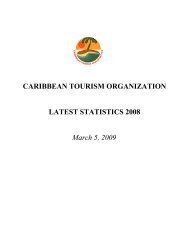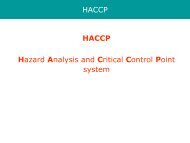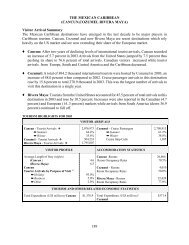Disaster Risk Management Strategy and Plan of Action - Caribbean ...
Disaster Risk Management Strategy and Plan of Action - Caribbean ...
Disaster Risk Management Strategy and Plan of Action - Caribbean ...
You also want an ePaper? Increase the reach of your titles
YUMPU automatically turns print PDFs into web optimized ePapers that Google loves.
Regional <strong>Disaster</strong> <strong>Risk</strong> <strong>Management</strong> <strong>Strategy</strong> for the Tourism Sector in the <strong>Caribbean</strong> – Final<br />
Glossary<br />
Climate change<br />
(a) The Inter-governmental Panel on Climate Change (IPCC) defines climate change as: “a change in the state <strong>of</strong> the<br />
climate that can be identified (e.g., by using statistical tests) by changes in the mean <strong>and</strong>/or the variability <strong>of</strong> its<br />
properties, <strong>and</strong> that persists for an extended period, typically decades or longer. Climate change may be due to<br />
natural internal processes or external forces or to persistent anthropogenic changes in the composition <strong>of</strong> the<br />
atmosphere or in l<strong>and</strong> use”.<br />
(b) The United Nations Framework Convention on Climate Change (UNFCCC) defines climate change as “a change<br />
<strong>of</strong> climate which is attributed directly or indirectly to human activity that alters the composition <strong>of</strong> the global<br />
atmosphere <strong>and</strong> which is in addition to natural climate variability observed over comparable time periods”.<br />
Comment: Contingency planning results in organized <strong>and</strong> coordinated courses <strong>of</strong> action with clearly- identified institutional roles<br />
<strong>and</strong> resources, information processes, <strong>and</strong> operational arrangements for specific actors at times <strong>of</strong> need. Based on scenarios <strong>of</strong><br />
possible emergency conditions or disaster events, it allows key actors to envision, anticipate <strong>and</strong> solve problems that can arise during<br />
crises. Contingency planning is an important part <strong>of</strong> overall preparedness. Contingency plans need to be regularly updated <strong>and</strong><br />
exercised.<br />
(United Nations International <strong>Strategy</strong> for <strong>Disaster</strong> reduction - UNISDR 2009)<br />
Comprehensive <strong>Disaster</strong> <strong>Management</strong> (CDM)<br />
CDM includes planning for all <strong>and</strong> responding to all hazards <strong>and</strong> threats (both natural <strong>and</strong> man-made) during all<br />
phases <strong>of</strong> the disaster cycle (mitigation, preparedness, response <strong>and</strong> recovery). It involves all levels <strong>of</strong> <strong>and</strong> sectors <strong>of</strong><br />
society in an integrated management approach. It requires continuous engagement <strong>of</strong> political <strong>and</strong> other decision<br />
makers.<br />
<strong>Disaster</strong><br />
A serious disruption <strong>of</strong> the functioning <strong>of</strong> a community or a society causing widespread human, material, economic<br />
or environmental losses which exceed the ability <strong>of</strong> the affected community or society to cope using its own<br />
resources.<br />
Comment: <strong>Disaster</strong>s are <strong>of</strong>ten described as a result <strong>of</strong> the combination <strong>of</strong>: the exposure to a hazard; the conditions <strong>of</strong> vulnerability<br />
that are present; <strong>and</strong> insufficient capacity or measures to reduce or cope with the potential negative consequences. <strong>Disaster</strong> impacts<br />
may include loss <strong>of</strong> life, injury, disease <strong>and</strong> other negative effects on human physical, mental <strong>and</strong> social well-being, together with<br />
damage to property, destruction <strong>of</strong> assets, loss <strong>of</strong> services, social <strong>and</strong> economic disruption <strong>and</strong> environmental degradation.<br />
(UNISDR 2009)<br />
<strong>Disaster</strong> <strong>Management</strong> (See Emergency <strong>Management</strong> below)<br />
<strong>Disaster</strong> risk management<br />
The systematic process <strong>of</strong> using administrative directives, organizations, <strong>and</strong> operational skills <strong>and</strong> capacities to<br />
implement strategies, policies <strong>and</strong> improved coping capacities in order to lessen the adverse impacts <strong>of</strong> hazards <strong>and</strong><br />
the possibility <strong>of</strong> disaster.<br />
Comment: This term is an extension <strong>of</strong> the more general term “risk management” to address the specific issue <strong>of</strong> disaster risks.<br />
<strong>Disaster</strong> risk management aims to avoid, lessen or transfer the adverse effects <strong>of</strong> hazards through activities <strong>and</strong> measures for<br />
prevention, mitigation <strong>and</strong> preparedness.<br />
(UNISDR 2009)<br />
vii

















